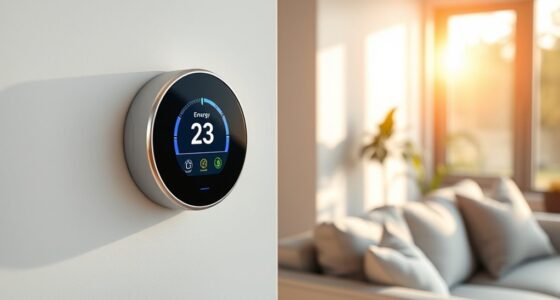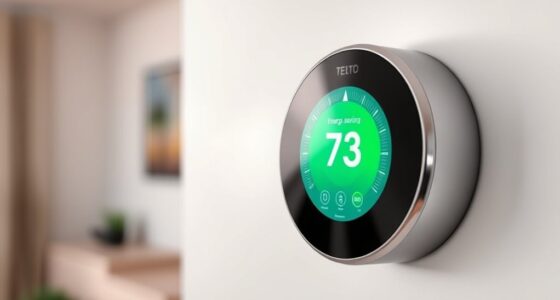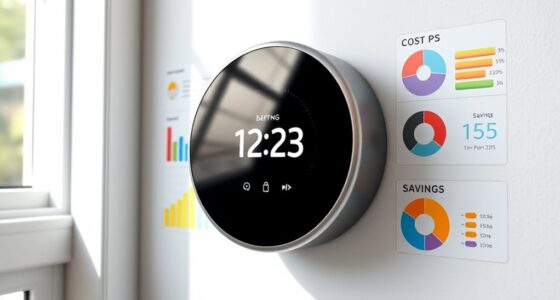In 2025, understanding your state’s specific rebate programs can help you save big on smart thermostats. Eligibility often depends on your location, utility provider, and choosing approved models, with some programs requiring professional installation. To maximize your incentives, gather all necessary documents and watch for deadlines. Staying updated on policy trends ensures you’ll benefit from upcoming opportunities. Keep exploring to learn how to make the most of these valuable savings options.
Key Takeaways
- Incentive programs vary by state and utility, so research local rebates for smart thermostats in 2025.
- Verify if your thermostat brand and installation method meet program requirements to qualify for rebates.
- Prepare necessary documentation like receipts and proof of installation to streamline rebate applications.
- Combine smart thermostat rebates with other energy-saving incentives, such as solar or home efficiency programs.
- Stay informed on evolving policies to maximize current incentives and plan future energy-efficient upgrades.
Understanding State-Specific Incentive Programs for 2025
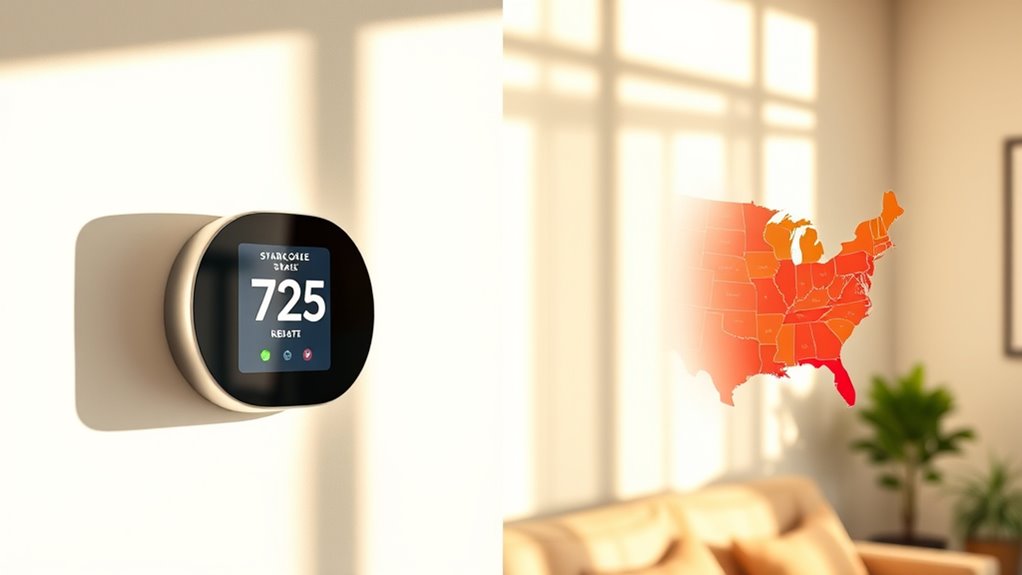
Understanding state-specific incentive programs for 2025 is essential because these programs can substantially reduce your costs and encourage adoption of energy-efficient technologies. Many states offer utility rebates that give you cash back when you install a smart thermostat, lowering the overall expense. Additionally, installation incentives are available in some areas, helping cover the costs of professional setup. These incentives vary by state and utility provider, so it’s important to research what’s available in your location. Taking advantage of utility rebates and installation incentives can make upgrading to a smart thermostat more affordable and rewarding. Furthermore, being aware of energy conservation initiatives can help you maximize benefits and contribute to broader environmental goals. Understanding how home energy efficiency programs work can help you identify additional savings opportunities. By understanding these programs early, you position yourself to maximize savings and contribute to sustainable energy efforts in your state.
How to Qualify for Smart Thermostat Rebates in Different States
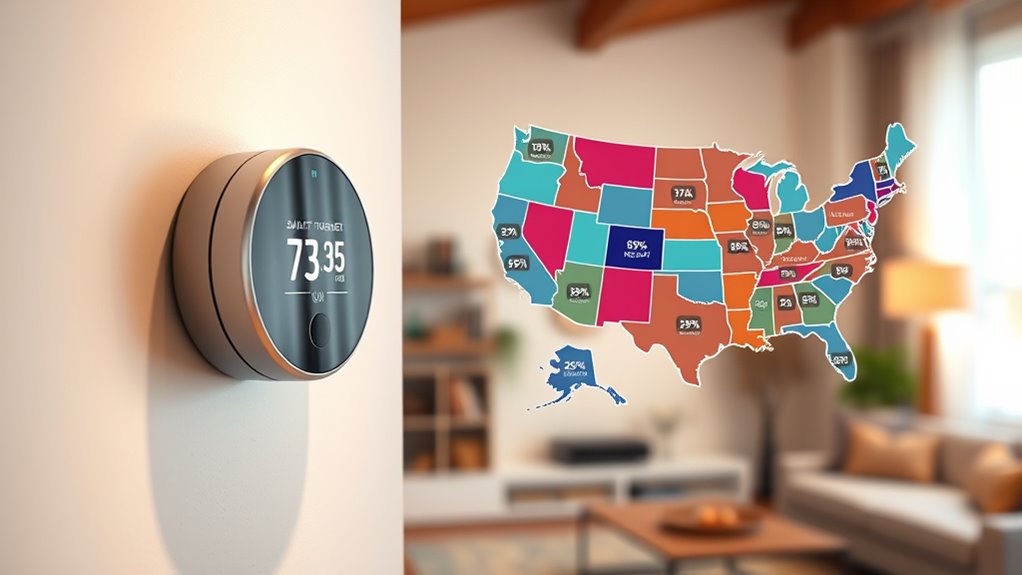
To qualify for smart thermostat rebates in different states, you need to meet specific eligibility criteria set by your local utility or state programs. First, check if your preferred smart thermostat brands are on the approved list, as some programs only cover certain models. Next, consider installation costs, since rebates often require professional setup to ensure proper operation and energy savings. Some programs may also specify that your thermostat must be installed by a certified technician. Additionally, you might need to be a current utility customer or reside within a designated area. Keep in mind that each state’s requirements vary, so reviewing your local program details will help you understand what documentation or proof of purchase might be necessary to qualify for the rebate. Furthermore, understanding state-specific incentives can help you maximize your savings and ensure compliance with local regulations. Being aware of program eligibility criteria can also improve your chances of successfully obtaining the rebate.
Key Requirements and Documentation for Rebate Applications

When applying for a smart thermostat rebate, you need to gather specific documentation to verify your eligibility and guarantee a smooth approval process. This typically includes proof of purchase, such as receipts or invoices, and sometimes photos of the installed thermostat. Be aware of rebate deadlines, as missing them can disqualify your application. Some programs also require proof of residence or utility account information. If your rebate offers installment options, ensure you understand the payment schedule and submit any necessary forms accordingly. Carefully review the application instructions to include all needed documentation, as incomplete applications can delay or prevent approval. Staying organized and submitting everything on time will help you maximize your chances of receiving the rebate without unnecessary setbacks. Additionally, keeping records of your energy-saving investments can support your application and demonstrate your commitment to efficient home improvements.
Tips to Maximize Your Savings and Incentive Benefits
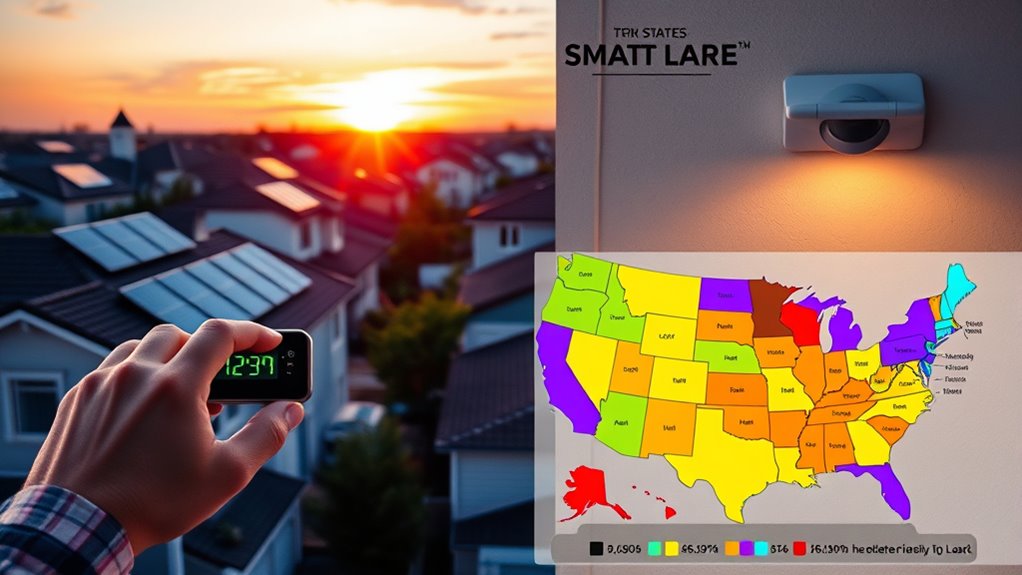
Maximizing your savings and incentive benefits requires careful planning and attention to detail. Start by prioritizing energy-efficient upgrades, like installing a smart thermostat, which can lower your energy bills and qualify for rebates. Combine this with renewable energy incentives if you’re considering solar panels or other renewable systems—many programs offer additional rebates for these upgrades. Research your state’s specific incentives to ensure you’re claiming all eligible benefits. Timing matters: complete upgrades when incentives are active and deadlines are approaching. Keep thorough documentation of all purchases and installations. Additionally, understanding the comfort solutions for enhancing home efficiency can help you select upgrades that maximize savings. Exploring energy-efficient technologies can further optimize your home’s performance and savings. Finally, bundle energy-efficient upgrades with renewable energy incentives to maximize savings. By strategizing your upgrades and staying informed about available programs, you’ll make the most of every dollar saved.
Navigating Future Trends and Policy Changes in Home Energy Incentives
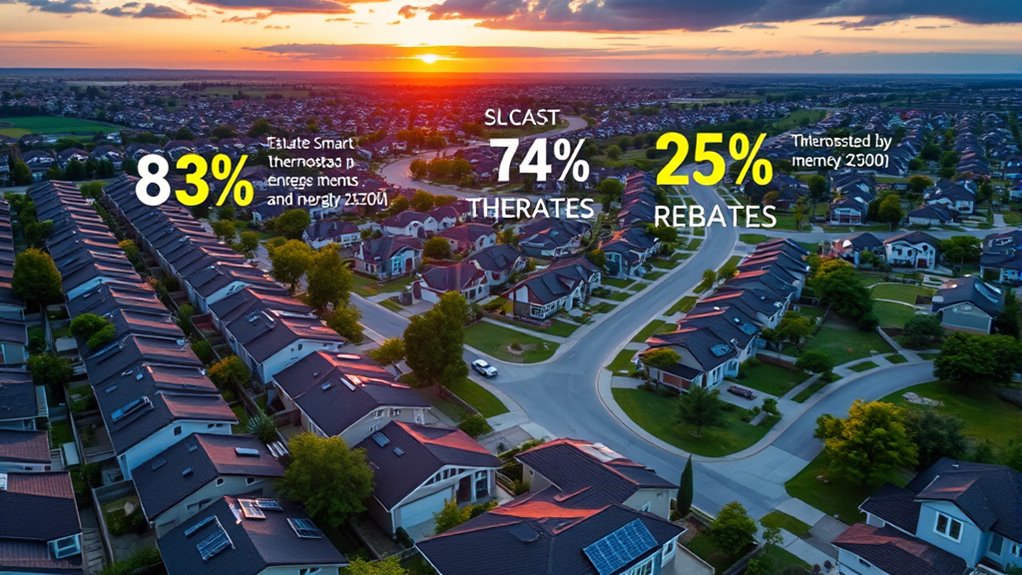
Staying ahead of future trends and policy shifts in home energy incentives helps you plan smarter upgrades and avoid missing out on valuable benefits. As renewable energy becomes more integral to energy policies, incentives may increasingly favor solar, wind, and other sustainable options. Additionally, advances in home automation are likely to influence future rebate programs, encouraging smart thermostats and integrated energy management systems. By monitoring policy changes, you can take advantage of upcoming incentives that promote renewable energy adoption and smarter home control. Staying informed ensures you maximize savings and align your upgrades with evolving standards. Preparing now allows you to incorporate energy-efficient solutions that meet future requirements, making your home more sustainable and cost-effective in the long run.
Frequently Asked Questions
Are There Income-Based Eligibility Criteria for Smart Thermostat Rebates?
You might wonder if income qualification affects smart thermostat rebates. Many programs do offer financial assistance based on income, making it easier for low- to moderate-income households to qualify. These incentives aim to promote energy efficiency and help reduce costs for eligible families. Check your state’s specific criteria to see if you qualify for income-based assistance, ensuring you don’t miss out on available rebates designed to support your energy-saving efforts.
Can I Combine Rebates From Multiple States or Programs?
You can often combine rebates from multiple states or programs if your state residency qualifies you and there are no program restrictions. However, check each program’s specific rules, as some limit you to one rebate per device or have other restrictions. To maximize your savings, review eligibility criteria carefully and contact program administrators if you’re unsure about combining offers. This way, you guarantee you’re staying compliant and getting the most benefits.
Do Rebate Programs Cover Installation Costs or Only the Device Purchase?
Rebate programs typically cover the device purchase, but some also include installation costs. It’s important to read the specific program details, as coverage varies by state and provider. You might find rebates that help with both expenses, but others only reimburse the device cost. Always check the eligibility requirements and whether installation costs are included before making your purchase, so you maximize your savings effectively.
Are There Specific Brands or Models of Smart Thermostats Eligible for Rebates?
Oh, the thrill of picking your smart thermostat—only to find some brands or models are off-limits! Yes, many rebate programs impose brand restrictions and model eligibility, so you can’t just choose any device. Before you get your heart set on that sleek, new model, double-check the list of approved brands and models to verify your pick qualifies. Otherwise, you might just be wasting your time and money!
How Long Do Rebate Offers Typically Remain Available Before Expiration?
Rebate expiration periods vary, but most offers stay available for a few months, typically between 3 to 6 months. You should check the specific offer’s timeline, as some programs may have shorter or longer durations. Keep in mind that offer duration timelines can change based on the program’s funding or seasonal incentives. To maximize your savings, act promptly before the rebate expiration period ends.
Conclusion
By staying informed about your state’s incentives, you can effortlessly make smarter choices for your home. With a little preparation and attention to detail, you’ll find it easier than ever to access these valuable savings. Keep an eye on future updates, and you’ll naturally stay ahead of the game. Remember, the path to a more energy-efficient home is smoother when you’re well-informed—so don’t hesitate to explore every opportunity that comes your way.



